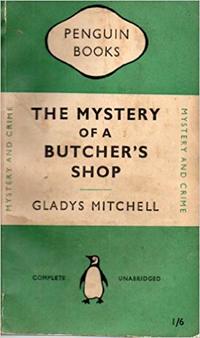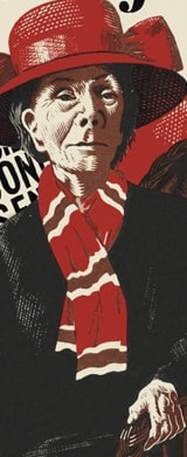There was one topic that every contributor mentioned in his or her comments: Gladys Mitchell's effective presentation of regional dialect when relating the speech of local characters. This is an element that appears throughout Mitchell's books, and it adds a great flavor to the stories, both in its definition of who those characters are (such as their education and class status) and as a colorful way to let these people tell their tale in their own words. It's interesting to remember that, in Mitchell's hands, Mrs. Bradley's speech never strays from the King's English; if she employs an idiom, she will almost always qualify it, drawing attention to the turn of phrase.
With her supporting characters, such as those who live in rural, rustic settings (such as the Ditches of Dead Men's Morris [1936]) or the proletariat working-class (like The Moon-Rocket Kid of 1970's Gory Dew or the landlord of the "Queen's Head" bar in Butcher's Shop), the author seems to delight in reproducing the syntax and sounds of these people on the page. Doing so often makes the reading and the dialogue come alive for the readers.
Mark Philpott observes that "Gladys Mitchell uses accents sparingly to give us necessary flavor of local dialogue. The scene where Mrs. Bradley is pumping the barman about the fight that occurred between Galloway and Wright does not overtax our patience as 21st-century readers in the way Ngaio Marsh can sometimes do. The fight description is brief and to the point. Mitchell moves on with her story, taking the reader with her."
"It wasn't too bad, mum, for about a round and a 'arf. Mr. Wright was nicely inside 'imself, and looked to me to 'ave the style and the science in 'itting. But at the end of Round Two 'e lets Galloway put 'im to the ropes—which is to say this 'ere counter—with a nasty left 'ook, and only the call of time saved 'im from punishment."
Catherine Dilts writes that she "didn’t feel Mitchell’s continual, lengthy reproduction of regional accents mocked the 'lower classes' but saw it as an affectionate appreciation for dialect." I would agree, and would note that the characters who use dialects throughout the Mrs. Bradley series of books are often sympathetic, lively, and content with and quietly proud of their lifestyles. Gladys Mitchell, a career schoolteacher, demonstrates a fondness for the working individuals who are not in the same social orbit of her moneyed, professionally-set detective.
My interpretation coincides with Joyka's: "When her characters start talking, they just leap off the pages for me. He or she may be routed for other reasons but never because they have less education or less money than 'their betters'." She notes that the language in Gladys Mitchell's books brings great enjoyment: "It is rich without being overwhelming, serious without lecturing. There are obvious cultural expressions we would not use today but their use is part of the story, not added for unnecessary effect."
ON STAGE MANAGING AND SPECTACLE
From Martyn Hobbs: "No one can rival Mrs Bradley in her dominance of the stage, both as protagonist and, as she says herself, 'stage manager'. She pops up all over the place like some devilish sprite or flibbertigibbet. She is a grotesque chimera, only human in parts. She is ghoulish, tigerish, saurian. Even her outer vestments are clashing and ill-matching (a rainbow-coloured jumper with checked tweeds) or simply ghastly (a hideous magenta silk dress and ludicrous black hat). She is a shapeshifter, a play-actor, sometimes appearing as a 'poor old thing... harmless... a case for a mental home', beaming with a smile of 'futile senility'; at others she is leering, smirking, with the smile of a 'Chinese executioner' or Cheshire Cat; and a past mistress of the fake coughing fit! Mrs Bradley (and GM) take pleasure in all these grotesque manifestations."
Martyn goes on to note that, at times, the author also imbues her predatory and monstrous protagonist with a more human, accessible side that creates an intriguing paradox. Is she a dangerous beast or a benign, even maternal presence? The answer, I presume, depends on the guilt or innocence of the person trying to calculate her personality. Kate writes that Chapter 17 "does reveal a small, softer, more domestic side to Mrs Bradley when she shows concern over Aubrey's flannels, which got ruined in the reconstruction of the crime. Normally, 'great detectives' do not notice such piffling matters, or if they do they don't feel there is any need on their part to do something about it."
Kate continues with this smart observation: "You may be thinking that if Mrs Bradley had been reading this book about herself, her self-esteem may have been knocked to smithereens. Yet interestingly we see her not only unbothered by criticisms and insults, but that she actually derives pleasure from identifying negative feelings towards her in others":
He disliked and mistrusted Mrs Bradley to a singularly flattering extent (at least, she thought his attitude flattering, for she had a habit of taking anybody's dislike of her person and character as a compliment of the highest order!).
"In the overly detailed and entirely unnecessary dramatic re-enactment of the murder, using Aubrey rather cruelly as a stand-in for the victim, she starts to undress him roughly and we get this odd line: '…and with the deftness born of nursing experience in mental hospitals she turned him over and pulled the shirt off.' This entire scene strikes me as a sign of an innate sadism in Mrs Bradley (she also slapped Felicity earlier in the book) that crops up every now and then in the series. I was really bothered by it and didn’t really find it funny. I thought all the play-acting was ludicrous, frankly. She could easily have just told everyone her theories of what happened in the woods rather than humiliating Aubrey in the role of the victim. A weird sense of humor on Gladys's part here, I’d say. Of course the other way would probably be dry and boring and with the re-enactment we get all sorts of farcical action. But still I thought it just dumb."
I offer a friendly and well-intentioned rebuttal to J.F.'s comments (both of which I'm very grateful to include here, since subjectivity and debate are always to be embraced!). Personally, I had no problem with the re-enactment stylistically or narratively. It does feel in keeping with the on-and-off-the-stage activity established in the first two chapters, where the Druid Stone and clearing is the performance set and space and the circle of trees acts as backdrop or audience or both. (Catherine noticed this continuation of a stage motif also.) Mrs. B's treatment of Aubrey – who is more precocious than he need be – is merely a meeting of cheek for cheek, and like Felicity, Aubrey doesn’t feel at all victimized. On the contrary, Mitchell includes the limited-third-person lines, "Aubrey walked on, around the immense Stone. This was rather a rag."
And finally, the re-enactment does serve a purpose, in my opinion: it gives the reader insight on how the sequence of events may have occurred, and it tests the theory of when, if Sethleigh's body were at the spot where Jim Redsey left it, the ambulatory Aubrey would have first noticed it. And you're absolutely right about how the restaging allows for showing and not telling, which is essential in theatrical story presentation. Whether GM incorporates this information effectively into the plot's conclusion is perhaps another conversation!
ON FERDINAND AND PHYSIOLOGY
Mrs. Bradley's barrister son Ferdinand Lestrange was memorably introduced in the prior story Speedy Death, where he took on the task of defending his mother against a charge of murder. Reference to him in the sequel has made a couple readers take note. Joyka writes, "Ferdinand has not coalesced yet. In this book he seems to be a different man [than in Speedy Death]. Cleaver Wright is trying to figure out Mrs. Bradley… He thinks her wrinkled yellow face is mild and sweet as a grandmother, and then this thought interrupts: "which owing to the extreme distaste displayed by her only son for the whole female sex, she certainly was not!” What?? I have to say these inconsistencies in the Mrs. B books delight me more than annoy me."
Felicity's grey eyes, lovely in their sweet seriousness, gazed unseeingly into the blue haze of the July morning. She had seated herself on the broad step which led into the garden and her hands were clasped round her knees. Mrs Bradley, looking at her, sighed inaudibly.
FINAL THOUGHTS (on Chapters 13 to 18)
Despite a dissatisfying crime scene re-creation, J.F. found these chapters to deliver on genre expectations: "The detective story elements are finely tuned in this section and the reader is truly engaged in the multiple mysteries. The game is on at this point."
Kate, referring specifically to Chapter 16: "Mrs Bradley is definitely not really working with the police, who in fact are not hugely grateful for her information. Interestingly, there are times where the police are actually farther ahead in some of the evidence than Mrs Bradley is. Yet this distance between the police and Mrs Bradley does slacken the pace of the novel and give the investigation less direction, as Mrs Bradley is not great at showing what she has in mind."
And I will echo Kate's comment that the inclusion of both the police investigation and the psycho-analyst's sometimes intuitive, enigmatic deductions can make the narrative feel meandering or unfocused, but the match between the amateur sleuth versus the conventional coppers to find a solution is a long-standing tradition of the murder mystery puzzle story. GM may have felt an obligation to use this structure here – or she may have been trying to gently parody it – but she soon abandoned the convention, preferring to use the police in most of her later novels mainly as vessels of information for Mrs. Bradley/Dame Beatrice whenever she would need them.
Next week, the reading group concludes with a (mostly spoiler-free) conversation about the final chapters of The Mystery of a Butcher's Shop. Comments are due via email to me by Monday, Nov. 26. Thanks to everyone who contributed so far!


 RSS Feed
RSS Feed